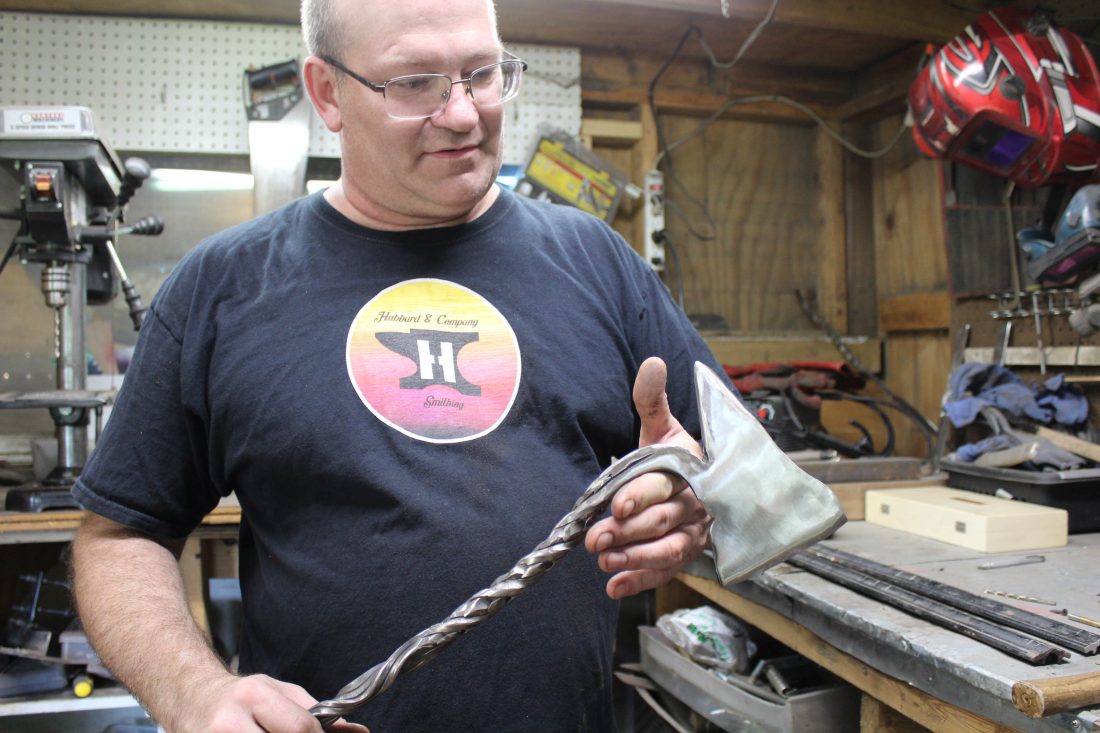Metal Magic: Family works their craft at a home forge

Tim Hubbard shows off an ax with an intricately worked handle. (Provided image — Katie Keyser/Cortland Standard)
Tim Hubbard has collected knives and swords his whole life.
“I always wanted to design and make my own,” said the Cortland man. “I thought about it for years,” he said.
He and his son, Nate, found an ax in the woods, took it home and cleaned it up, grinding off the rust and sharpening the blade. Playing with metal was irresistible.
“I made a shop in here for rudimentary working on stuff with hand tools, a grinder. We made a forge out of a barbecue,” said Tim, a supervisor at United Parcel Service.
Nate and Tim’s other son, Chris, wanted to learn metal work, so expanded the shop with a forge, anvil and grinder on family property in Cortland.
Now they have a small hobby business, Hubbard and Company Smithing.
In their barbecue forge, they used wood, charcoal and coal to heat and work the metal.
“You need anthracite coal,” said Chris Hubbard, a postal clerk for the U.S. Postal Service in Locke. “Charcoal doesn’t burn hot enough or long enough.”
But the barbecue forge didn’t heat consistently.
“Once you start to blacksmith, you learn it’s important to control the heat,” said Tim Hubbard.
Tim’s kids bought him a propane-fueled forge.
Their shop is packed with tools: hammers and tongs they got from garage sales. They have a drill press.
“The grinder I made,” said Tim Hubbard.
Over the past four years, they’ve honed their craft, creating metalwork — bottle openers, wands, jewelry, knives and hairsticks. They have a presence on Etsy.
“We will take business any time,” said Tim Hubbard.
They’ve had customers as far away as Sweden and England.
“Chris is good with jewelry. Nate, the decorative stuff. Chris is much better with rings and smaller things than I am,” said Tim.
Kate Hubbard, Chris’ wife, is the business manager while Nate cares for shipping and handling.
When they do a specialty event every so often, they get the necessary vendor’s license.
“If you think of something, we can make it happen,” said Chris Hubbard.
If they don’t know how to make a piece, they will break down the process to learn it step by step, he said.
Dustin L. Kauffman of Yelm, Washington, has been a hobby blacksmith for three years and is a member of the Artist-Blacksmith’s Association of North America, which fosters the art of blacksmithing. It’s been a great learning tool with classes and gatherings, he said, until the COVID-19 pandemic.
Kauffman has no power in his shop, using a hand-cranked blower and coal to heat the metal. He chisels by hand. He even uses oil to light the area. Kauffman does not live off the grid, he just likes work the old ways.
“I like to do things the way they used to do things,” he said. “It kind of puts more of yourself into it.”
“There’s a lot of tradition and technique passed down,” he said. “That stuff should not be lost.”
“I feel like everyone should work with their hands, at least try it out,” he said.
“Basically, if anyone wants to make something, you have to take the leap and try,” said Chris Hubbard. “Don’t expect to be good at it at day one.”
“This is all learning through trial and error, and through YouTube,” he said.
Tim made his own grinder, which sands down metal with special belts.
“To buy something like that is $5,000. Most hobby smiths make their own. There are websites dedicated to this. The blacksmith community is welcoming and nice to everyone. You ask a question, they answer it, said Tim.”
“Keep at it,” he advised. “Eventually, you will get enough tools together.”
“Do what you can with what you’ve got,” Nate said.
Chris put up a sign on the bulletin board at work saying he was looking for an anvil. He figured it anyone would have one, it would be a person in the country.
A customer sol him a 140-pound anvil for $80. They typically $1,000 to $2,000, but the fellow just wanted it to be used.
The Hubbards find steel at the Route 90 garage sales or people give it to them, or perhaps the Tractor Supply Store.
“A neighbor gave us iron from a fence,” Chris said.
“That was a lawn mower blade,” said Tim Hubbard, pointing to a knife. “Now it’s a chef’s knife.”
What they find decides what they make. Wands require low-carbon steel. Knives and blades need high-carbon steel.
“We mostly used railroad spikes when we were first learning,” Chris said. “That taught us how to do a lot of twists and cuts.”
“We learned how to straighten things out,” said Tim. “I like the twist. That’s kind of my thing.”
Tim taught himself how to make Damascus steel by hand, fusing two types of carbon steel together through super-high heat and pressure.
“And you do twists to make them fuse together,” he said. “A customer ordered it. We did it. That’s the only way I will do it again.”
He also made a pattern on the metal using acid, then bathing it.
It’s not just the steel and iron. They work in copper, too.
“I love copper,” said Chris. “It’s fun.”
“It melts easily,” said Kate Hubbard.
“I like the ability to imagine something and be able to make that happen. I can take a lump of steel and make something that was in my head,” said Chris.
“It’s really cool when someone gives you a picture: ‘Can you make this for me?’ And then you do it,” Tim said. “It’s a tremendous feeling when you do it.”
